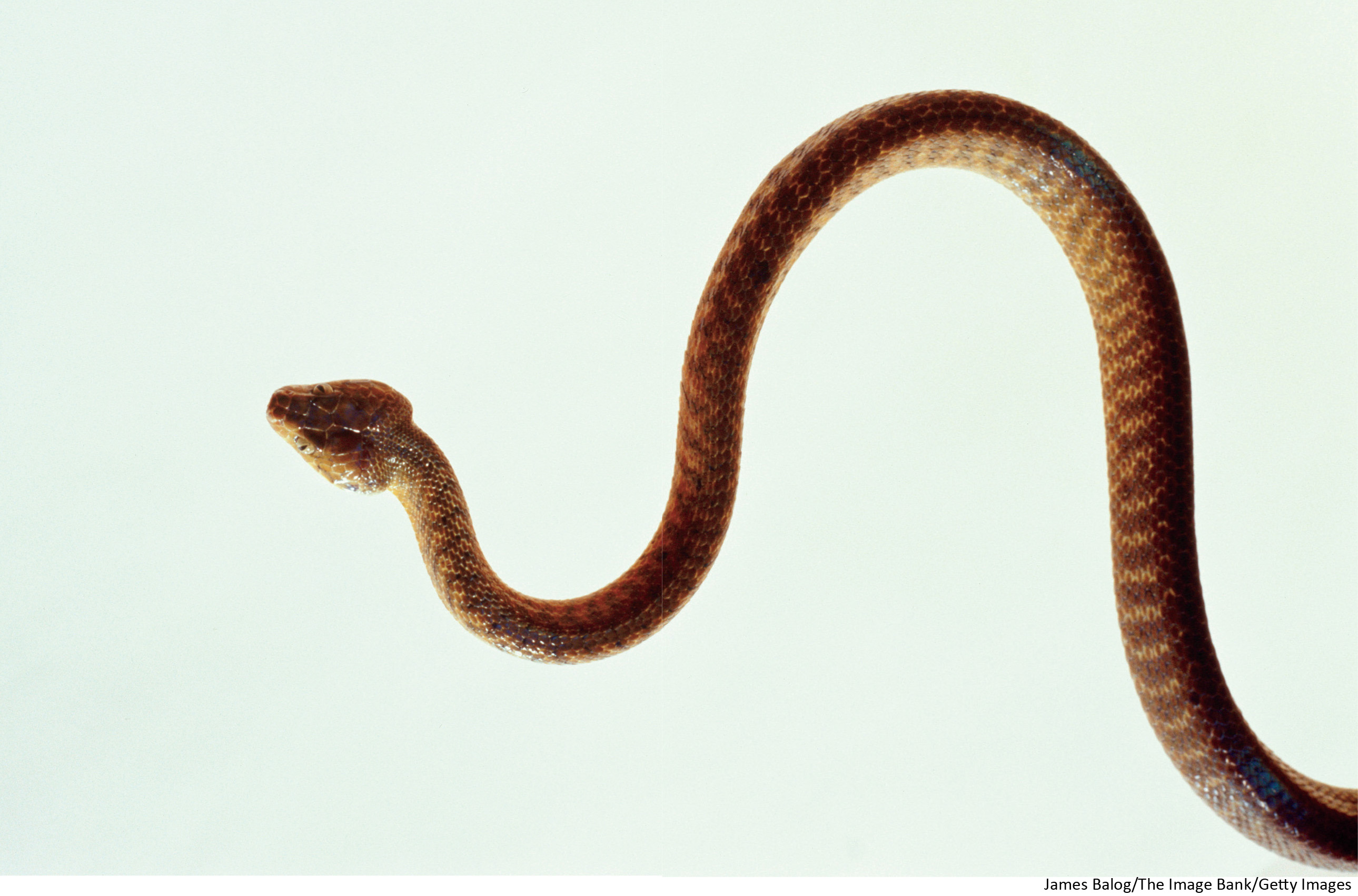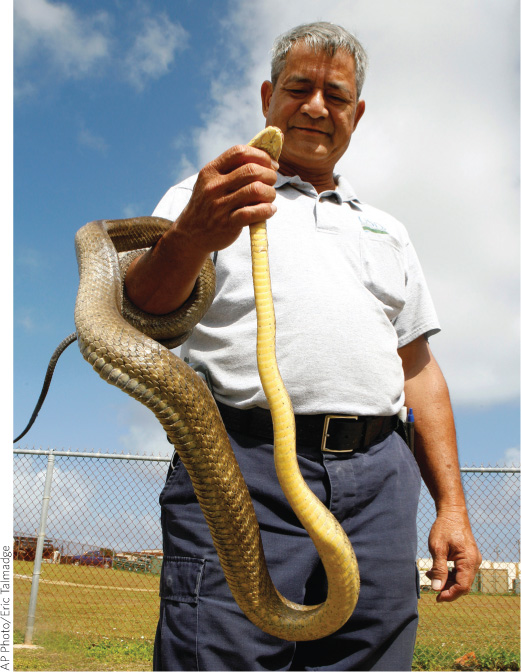Chapter Introduction
CHAPTER 11
EVOLUTION AND EXTINCTION
A TROPICAL MURDER MYSTERY
Finding the missing birds of Guam

CORE MESSAGE
The variety of life on Earth is a result of natural selection favoring the individuals within populations that are best able to survive in their particular environment. Given enough time, populations may be able to adapt to environmental changes, but extinction is also a natural part of this process, as less adapted populations are eliminated by better competitors or are lost due to natural disasters. Human activities can introduce changes so quickly that some populations of other species cannot adapt fast enough to survive and may go extinct.
AFTER READING THIS CHAPTER, YOU SHOULD BE ABLE TO ANSWER THE FOLLOWING GUIDING QUESTIONS
On a crisp December morning in 2013, representatives of several federal agencies met on Anderson Air Force Base in Guam—a south pacific island and U.S. territory—to watch an experiment that sounded more like science fiction than science. As they looked on with binoculars, military personnel in a small fleet of helicopters dropped dead baby mice, one-by-one, into the surrounding jungle. The mice had been laced with acetaminophen and fitted with mini-parachutes. some of them had also been implanted with tiny radio transmitters.
Though dead, the mice might still be thought of as paratroopers in a war that the island has been fighting for half a century, against a most elusive, yet devastating, enemy: brown tree snakes. The snakes are believed to have been accidently introduced from their native home on other Pacific islands to Guam through ships sometime back in the 1940s or 1950s; they have driven almost all of the island’s native bird species to extinction, and it is feared that they will eventually sneak off the island through one of the base’s aircraft, invade other islands, and devastate other bird populations in the region.

As in any good military campaign, though, the scientist-generals in this war have studied their enemy well and are now making use of two of the tree snake’s biggest weaknesses: their susceptibility to a common painkiller, acetaminophen, and their lack of pickiness at meal time. Acetaminophen is safe for human use (at the correct dose) but lethal to the snakes, who, unlike other species, are quite happy to eat prey that has already been killed.
The parachutes were employed to ensure that the mice would catch in the trees, where the snakes live and eat, rather than plummet to the ground, where they might be eaten by some other creature. The radio transmitters were meant to help the U.S. Department of Agriculture (USDA) scientists track the mice in order to determine whether they were eaten by the snakes and whether the snakes died as a result. It was a spectacular-looking feat to be sure. But desperate wars call for desperate measures, and no island has a tree-snake problem more desperate than Guam’s.
“There really is no other place in the world with a snake problem like this,” says Daniel Vice, assistant state director of the USDA’s Wildlife Services in Hawaii, Guam, and the Pacific Islands. The December test drop was the fourth of its kind; mice were dropped over two 136-acre test plots. If it works—that is, if the snakes eat the mice, and the drug then kills the snakes—the project will be scaled up to cover more of the island. And if that works, operation mouse-drop will help address a problem that has plagued wildlife biologists for half a century and that for years was shrouded in mystery.
It was the late 1960s when the birds of Guam—some 18 native avian species that had long filled the forests with song—began dying off with disturbing speed. By the early 1980s, 4 species had gone extinct, and 10 others were in danger of joining them. Worst of all, researchers and wildlife experts had no clue why.
Back in the United States, in the winter of 1980, biologist Julie Savidge was gearing up to begin PhD work at the University of Illinois when she by chance attended a lecture in Redding, California, organized by the Wildlife Society. A biologist from Guam had been invited to talk about the island’s bird disappearances, and he noted—rather grimly—that no one had yet solved the devastating mystery. Savidge was immediately enthralled. “I went up to him afterwards and said, ‘This sounds fascinating. Is there any way that I might be able to get out to Guam?’” Savidge recalls.

Two summers later, after much back-and-forth between Savidge and the Guam Division of Aquatic and Wildlife Resources, Savidge was hired to investigate the bird disappearances as part of her PhD dissertation.
At the time, Guam’s scientists were convinced that diseases like blood parasites or pesticides were to blame for the avian losses. So Savidge began looking into those possibilities. But as soon as she started talking to Guam locals, she became skeptical of the idea. “When I would interview the natives, I’d be asking all these disease questions, and they’d say, ‘Why are you asking about this? The real problem is the snakes,’” she explains.
The locals were certain that brown tree snakes (Boiga irregularis), 1- to 2-meter-long (3- to 6-foot-long), non-native snakes that had been accidentally introduced to the islands in military shipping cargo in the late 1940s and 1950s, were responsible for the birds’ demise. Non-native species that cause ecological, economic, or human health problems and are hard to eradicate are considered invasive species, and they can cause significant damage in areas they invade. In fact, invasive species are the second leading cause of species endangerment, worldwide (see Chapter 13).
invasive species
A non-native species (a species outside its range) whose introduction causes or is likely to cause economic or environmental harm or harm to human health.
Oddly, Savidge’s research was starting to show that, in fact, diseases weren’t playing a factor in the bird deaths at all. When she and her colleagues sampled a variety of birds for bacteria, viruses, and parasites between 1982 and 1985, they found that the native birds were basically healthy. Curious about the tree snake hypothesis (an idea other scientists had dismissed), Savidge began to investigate, on her own time, whether these reptiles might be causing the extinctions. Surely it was something else; could a few snakes really obliterate a whole island’s worth of birds?
extinction
The complete loss of a species from an area; may be local (gone from an area) or global (gone for good).